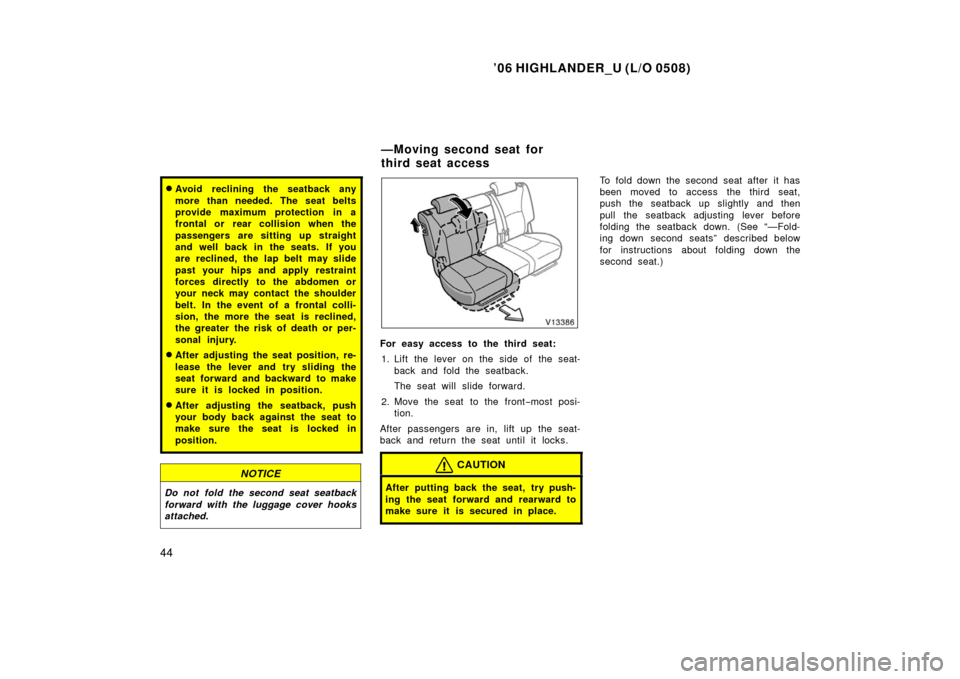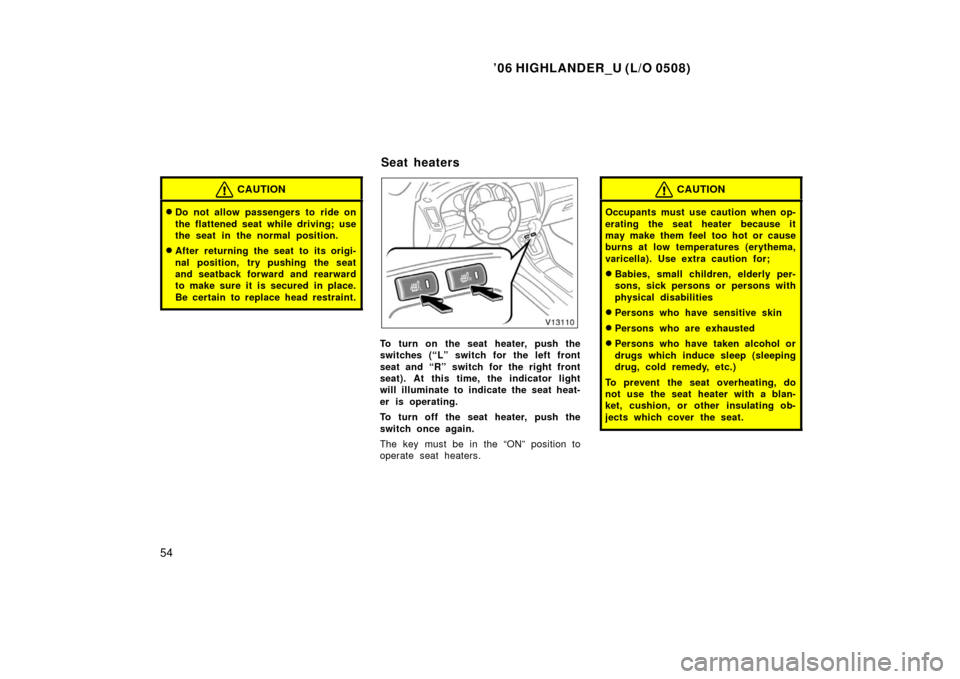Page 46 of 428

’06 HIGHLANDER_U (L/O 0508)
36
When you quickly push and release the
switch, the moon roof will tilt down while
the switch is depressed and stop when
released.
Key off operation: If all the side doors
and back door are closed, it works for 43
seconds even after the ignition switch is
turned off. It stops working when either
front door is opened.
Jam protection function:
�If something gets caught between the
moon roof and frame during slide clos-
ing operation, the moon roof stops and
then opens slightly.
�If something gets caught between the
moon roof and frame during tilting
down operation, the moon roof stops
and then tilts up fully.
If the moon roof receives a strong impact,
this function may work even if nothing is
caught.
CAUTION
To avoid serious personal injury, you
must do the following.
�While the vehicle is moving, always
keep the heads, hands and other
parts of the bodies of all occupants
away from the roof opening. Other-
wise, they could be seriously in-
jured if the vehicle stops suddenly
or if the vehicle is involved in an
accident.
�Before you close the moon roof,
always make sure there is nobody
around the moon roof. You must
also make sure nobody places his
or her head, hands and other parts
of the body in the roof opening. If
someone’s neck, head or hands get
caught in the closing roof, it could
result in death or serious injury.
When anyone closes the moon roof,
first make sure it is safe to do so.
�Be sure to remove the ignition key
when you leave your vehicle.
�Never leave anyone (particularly a
small child) alone in your vehicle,
especially with the ignition key still
inserted. Otherwise, he/she could
use the moon roof switch and get
trapped in the roof opening. Unat-
tended person (particularly a small
child) can be involved in a serious
accident.
�Never sit on top of the vehicle
around the roof opening.
�Never try jamming any part of your
body to activate the jam protection
function intentionally, as it could re-
sult in a serious injury.
�The jam protection function may
not work if something gets caught
just before the moon roof is fully
closed.
Page 48 of 428

’06 HIGHLANDER_U (L/O 0508)
38
While the vehicle is being driven, all ve-
hicle occupants should have the seatback
upright, sit well back in the seat and prop-
erly wear the seat belts provided.
CAUTION
�Do not drive the vehicle unless the
occupants are properly seated. Do
not allow any passengers to sit on
top of a folded�down seatback, or
in the luggage compartment or car-
go area. Persons not properly
seated and/or not properly re-
strained by seat belts can be se-
verely injured in the event of emer-
gency braking or a collision.
�During driving, do not allow any
passengers to stand up or move
around between seats. Otherwise,
severe injuries can occur in the
event of emergency braking or a
collision.
Driver seat
CAUTION
The SRS driver airbag deploys with
considerable force, and can cause
death or serious injury especially if
the driver is very close to the airbag.
The National Highway Traffic Safety
Administration (“NHTSA”) advises:
Since the risk zone for driver airbag
is the first 50—75 mm (2—3 in.) of
inflation, placing yourself 250 mm (10
in.) from your driver airbag provides
you with a clear margin of safety.
This distance is measured from the
center of the steering wheel to your
breastbone. If you sit less than 250
mm (10 in.) away now, you can
change your driving position in sever-
al ways:
�Move your seat to the rear as far
as you can while still reaching the
pedals comfortably.
�Slightly recline the back of the
seat. Although vehicle designs vary,
many drivers can achieve the 250
mm (10 in.) distance, even with the
driver seat all the way forward, sim-
ply by reclining the back of the
seat somewhat. If reclining the back
of your seat makes it hard to see
the road, raise yourself by using a
firm, non�slippery cushion, or raise
the seat if your vehicle has that
feature.
�If your steering wheel is adjustable,
tilt it downward. This points the air-
bag toward your chest instead of
your head and neck.
The seat should be adjusted as rec-
ommended by NHTSA above, while
still maintaining control of the foot
pedals, steering wheel, and your view
of the instrument panel controls.
Seats Front seats—
—Front seat precautions
Page 50 of 428
’06 HIGHLANDER_U (L/O 0508)
40
�While adjusting the seat, do not put
your hands under the seat or near
the moving parts. Otherwise, your
hands or fingers may be caught and
injured.1. SEAT POSITION ADJUSTING LEVER
Hold the center of the lever and pull it
up. Then slide the seat to the desired
position with slight body pressure and
release the lever.
2. SEAT CUSHION ANGLE ADJUSTING KNOB
To change the angle of the seat cush-
ion on the front side, turn the knob
either way.
3. SEAT HEIGHT ADJUSTING LEVER
To change the height of the seat, pull
up or push down the lever.
4. SEATBACK ANGLE ADJUSTING LEVER
Lean forward and pull the lever up.
Then lean back to the desired angle
and release the lever.
—Adjusting front seats
(manual seat)
Page 53 of 428
’06 HIGHLANDER_U (L/O 0508)
43
Vehicles with third seatVehicles without third seat
1. SEAT POSITION ADJUSTING LEVER
Hold the center of the lever and pull it
up. Then slide the seat to the desired
position with slight body pressure and
release the lever.
2. SEATBACK ANGLE ADJUSTING LEVER
Pull the lever up. Then lean back to the
desired angle and release the lever.
CAUTION
�Do not adjust the seat while the
vehicle is moving.
�Be careful that the seat does not
hit a passenger or luggage.
—Adjusting second seats
Page 54 of 428

’06 HIGHLANDER_U (L/O 0508)
44
�Avoid reclining the seatback any
more than needed. The seat belts
provide maximum protection in a
frontal or rear collision when the
passengers are sitting up straight
and well back in the seats. If you
are reclined, the lap belt may slide
past your hips and apply restraint
forces directly to the abdomen or
your neck may contact the shoulder
belt. In the event of a frontal colli-
sion, the more the seat is reclined,
the greater the risk of death or per-
sonal injury.
�After adjusting the seat position, re-
lease the lever and try sliding the
seat forward and backward to make
sure it is locked in position.
�After adjusting the seatback, push
your body back against the seat to
make sure the seat is locked in
position.
NOTICE
Do not fold the second seat seatback
forward with the luggage cover hooks
attached.
For easy access to the third seat:
1. Lift the lever on the side of the seat- back and fold the seatback.
The seat will slide forward.
2. Move the seat to the front −most posi-
tion.
After passengers are in, lift up the seat-
back and return the seat until it locks.
CAUTION
After putting back the seat, try push-
ing the seat forward and rearward to
make sure it is secured in place.
To fold down the second seat after it has
been moved to access the third seat,
push the seatback up slightly and then
pull the seatback adjusting lever before
folding the seatback down. (See “—Fold-
ing down second seats” described below
for instructions about folding down the
second seat.)
—Moving second seat for
third seat access
Page 61 of 428
’06 HIGHLANDER_U (L/O 0508)
51
RETURNING THIRD SEAT
Pull the seatback adjusting lever to un-
lock the seatback and fold up the seat-
back to its upright lock position.
CAUTION
When returning the seatback to the
upright position, observe the follow-
ing precautions in order to prevent
personal injury in a collision or sud-
den stop:
�Make sure the seatback is securely
locked by pushing forward and rear-
ward on the top of the seatback.
Failure to do so will prevent the
seat belt from operating properly.
�Make sure the seat belts are not
twisted or caught under the seat
and are arranged in their proper
position and are ready to use.To flatten the seatbacks, do the follow-
ing:
1. Hold the center of the lever and pull it up, sliding the second seat to the
rear�most position. Then pull the
seat forward slightly until it locks.
Flattening seatbacks
(manual seat)
Page 63 of 428
’06 HIGHLANDER_U (L/O 0508)
53
To flatten the seatbacks, do the follow-
ing:
1. Hold the center of the lever and pull it up, sliding the second seat to the
rear�most position. Then pull the
seat forward slightly until it locks.2. Remove the head restraint. Push theseat position adjusting switch for-
ward to slide the front seat to the
front�most position.3. Move the seatback angle adjustingswitch backward to flatten the seat-
back.
After returning the seat to its original
position, be certain to replace the head
restraint.
Flattening seatbacks
(power seat)
Page 64 of 428

’06 HIGHLANDER_U (L/O 0508)
54
CAUTION
�Do not allow passengers to ride on
the flattened seat while driving; use
the seat in the normal position.
�After returning the seat to its origi-
nal position, try pushing the seat
and seatback forward and rearward
to make sure it is secured in place.
Be certain to replace head restraint.
To turn on the seat heater, push the
switches (“L” switch for the left front
seat and “R” switch for the right front
seat). At this time, the indicator light
will illuminate to indicate the seat heat-
er is operating.
To turn off the seat heater, push the
switch once again.
The key must be in the “ON” position to
operate seat heaters.
CAUTION
Occupants must use caution when op-
erating the seat heater because it
may make them feel too hot or cause
burns at low temperatures (erythema,
varicella). Use extra caution for;
�Babies, small children, elderly per-
sons, sick persons or persons with
physical disabilities
�Persons who have sensitive skin
�Persons who are exhausted
�Persons who have taken alcohol or
drugs which induce sleep (sleeping
drug, cold remedy, etc.)
To prevent the seat overheating, do
not use the seat heater with a blan-
ket, cushion, or other insulating ob-
jects which cover the seat.
Seat heaters